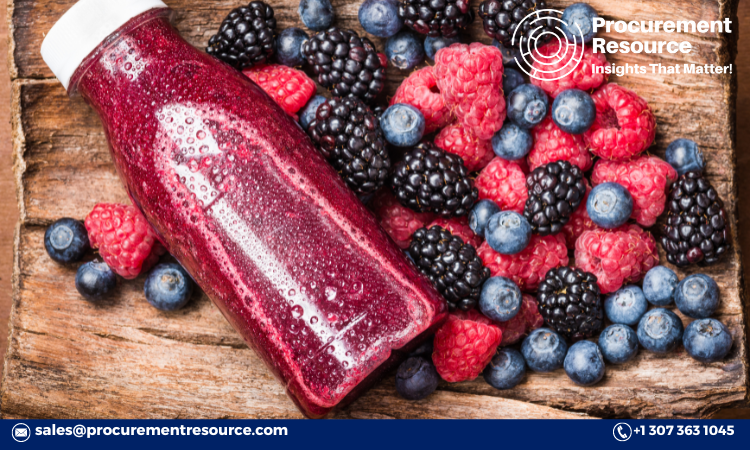
Raspberry juice is a popular beverage known for its rich flavor and numerous health benefits. As the demand for natural and organic juices continues to rise, understanding the production cost of raspberry juice becomes crucial for businesses looking to enter or expand in this market. This blog delves into the various aspects of raspberry juice production costs, providing a comprehensive overview of the production process, raw material costs, and the latest news in the industry.
Production Process
The production process of raspberry juice involves several key steps, each contributing to the overall cost. Here’s a detailed look at each stage:
- Harvesting: The first step involves harvesting ripe raspberries. This can be done manually or mechanically, with the method chosen affecting both cost and efficiency. Manual harvesting, while labor-intensive, ensures higher quality berries but comes at a higher cost. Mechanical harvesting is quicker and cheaper but may result in some berry damage.
- Sorting and Cleaning: Once harvested, the raspberries are sorted to remove any unripe, damaged, or foreign material. The berries are then thoroughly washed to remove dirt, pesticides, and other impurities. This stage involves labor costs and the use of water and cleaning agents.
- Juicing: The cleaned raspberries are then crushed to extract juice. This can be done using various methods, such as cold pressing or centrifugal juicing. The choice of method impacts the juice yield and quality, thereby influencing production costs. Cold pressing, though costlier, retains more nutrients and flavor compared to centrifugal juicing.
- Filtration and Pasteurization: The extracted juice is filtered to remove pulp and seeds. It is then pasteurized to kill any harmful microorganisms, ensuring the juice is safe for consumption and has a longer shelf life. This step requires specialized equipment and energy, contributing to the production cost.
- Packaging: The final stage involves packaging the juice in bottles, cartons, or pouches. Packaging material and design play a significant role in cost, as well as the machinery used for filling and sealing the containers. Glass bottles, while more expensive, are preferred for premium products due to their aesthetic appeal and recyclability.
Request For Sample: https://www.procurementresource.com/production-cost-report-store/raspberry-juice/request-sample
Manufacturing Report and Process
The manufacturing report for raspberry juice provides a detailed breakdown of each stage of production, highlighting the associated costs and potential areas for cost savings. Key elements of the report include:
- Equipment Costs: This includes the cost of purchasing, installing, and maintaining machinery used in the production process. Investing in high-quality, efficient equipment can reduce long-term operational costs and increase production capacity.
- Labor Costs: Labor is a significant component of production costs, especially in stages like harvesting and sorting. The report analyzes labor requirements and explores options for automation to optimize costs.
- Energy Costs: Energy consumption in processes like pasteurization and juicing impacts the overall production cost. The report evaluates energy-efficient technologies and practices to reduce energy usage.
- Water Usage: Water is essential for cleaning and processing raspberries. Efficient water management practices and recycling systems can help lower costs and minimize environmental impact.
- Quality Control: Maintaining high-quality standards involves costs related to quality control tests, certifications, and compliance with regulatory requirements. The report outlines these expenses and suggests best practices for quality assurance.
Raw Material Costs
Raw material costs constitute a significant portion of the overall production cost of raspberry juice. Key factors influencing these costs include:
- Berry Procurement: The cost of raspberries varies based on factors like seasonality, location, and farming practices. Organic raspberries tend to be more expensive than conventionally grown ones due to higher cultivation costs.
- Transportation: The cost of transporting raspberries from farms to processing facilities affects the overall cost. Proximity to raspberry farms can help reduce transportation expenses.
- Storage: Proper storage facilities are essential to maintain the quality of raspberries before processing. The cost of refrigeration and storage infrastructure is an important consideration.
- Additives and Preservatives: If the juice recipe includes additives like sugar, preservatives, or flavor enhancers, these contribute to the raw material costs. Opting for natural or organic additives may increase costs but can appeal to health-conscious consumers.
Latest News
Staying updated with the latest news and trends in the raspberry juice industry is crucial for making informed business decisions. Here are some recent developments:
- Technological Advancements: Innovations in juicing technology are improving efficiency and reducing production costs. For instance, new cold-pressing machines offer higher yield and better nutrient retention, enhancing product quality.
- Sustainability Initiatives: There is a growing emphasis on sustainable practices in juice production. Companies are investing in eco-friendly packaging, energy-efficient machinery, and sustainable farming practices to reduce their environmental footprint and appeal to environmentally conscious consumers.
- Market Trends: The demand for organic and natural juices continues to rise, driven by increasing health awareness. Consumers are willing to pay a premium for products that are free from artificial additives and preservatives.
- Regulatory Changes: Changes in food safety and labeling regulations impact production costs. Companies must stay compliant with these regulations to avoid penalties and maintain consumer trust.
- Global Market Dynamics: The global raspberry juice market is influenced by factors like trade policies, economic conditions, and consumer preferences. For instance, a rise in raspberry imports from major producing countries can affect local production costs.
In conclusion, understanding the production cost of raspberry juice involves a detailed analysis of various factors, including the production process, raw material costs, and industry trends. By optimizing these factors, businesses can reduce costs, improve efficiency, and remain competitive in the growing market for natural and organic beverages. Staying updated with the latest news and advancements in the industry is essential for making informed decisions and capitalizing on emerging opportunities.






